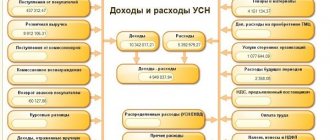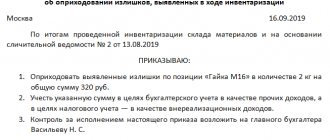Property tax: accrual entries
Companies using OSNO, as well as companies using the simplified tax system and UTII, pay the tax if they are the owners of real estate, which is recorded on the balance sheet of the enterprise and is used for production purposes. Since the reflection of tax calculation transactions directly depends on the provisions enshrined in the CP, there are 2 options for accounting entries:
- If the company does not consider taxes in the context of expenses for ordinary activities, then account 91 is used in the calculation. In this case, if the organization’s property tax is charged, the posting will be as follows - D/t 91 K/t 68;
- If in the accounting of a company taxes are classified as expenses of ordinary types, then:
- — manufacturing non-trading organizations record the accrual of tax by recording D/t 20 (23, 25, 26) K/t 68;
- — trading enterprises record D/t 44 K/t 68.
There are also some peculiarities in the calculation of the fee. Since it is regional, the frequency of its calculation and payment is established by orders of local authorities. It is calculated and paid at the end of the calendar year if the reporting period is abolished by regional law. But usually enterprises are required to pay quarterly advances. For the calculation, the tax base and rate are determined.
The base is considered to be the average annual value of assets, but for a number of objects the tax is calculated from their value according to the cadastre. These include shopping, business and office centers, industrial premises included in the lists of cadastral property by region.
Legislative framework
Payers of property tax are all legal entities that own taxable objects.
Officials have provided for relaxations. So, for example, companies that have switched to special tax regimes are exempt from paying property tax (IP). However, there are exceptions to this rule. Enterprises and organizations that apply special regimes are required to pay IP if they own special types of property. The list of these categories of fixed assets is approved by the legislative authorities of the constituent entities of the Russian Federation.
Since IP is a regional tax, the authorities of the subject have the right to approve reporting periods for fiscal payments. This means that taxpayers, in addition to the mandatory final payment (paid once a year based on the results of the tax period - year), can transfer advance payments to the budget.
You can find out what frequency of payments is established in your region in 2020 on the official website of the Federal Tax Service.
When calculating property tax, entries must be reflected in accounting and tax records. Moreover, the preparation of accounting records has its own characteristics. We'll talk about them further.
Corporate property tax rate
Graduation by cost also implies different tax rates. Regions are given the right to establish them independently, without exceeding the maximum (Article 380 of the Tax Code of the Russian Federation), sizes:
- 2.2% for calculation at the average annual cost;
- 2% - at cadastral value, with the exception of specific fixed assets (pipelines, power supply lines, etc., for them in 2020 the rate is 1.6%).
If the regional authorities have not fixed the tax rate, then it is calculated according to the rates of the Tax Code of the Russian Federation.
Tax accounting. simplified tax system
As a general rule, simplified organizations do not pay property tax. The exception is for organizations that have real estate on their balance sheet, for which the tax base is determined as cadastral value. Property tax on these objects must be paid on a general basis (clause 2 of Article 346.11 of the Tax Code of the Russian Federation).
If an organization calculates a single tax on income, then the property tax paid will not reduce the tax base (clause 1 of Article 346.15 of the Tax Code of the Russian Federation). If an organization pays tax on the difference between income and expenses, include the amount of property tax as expenses in the period when it was transferred to the budget (subclause 22, clause 1, article 346.16, clause 2, article 346.17 of the Tax Code of the Russian Federation).
How is corporate property tax calculated based on the average annual cost?
The tax amount is calculated as follows:
- determine the average cost by summing the residual value at the beginning of each month in the billing period + on the 1st day of the next month;
- the result is divided by the number of months in the period + 1.
For example, to calculate the tax for the 1st quarter, it is necessary to determine the sum of the values of the residual value of the property as of January 1, February 1, March 1 and April 1. Let's assume that the values will be as follows:
- on January 1 - 120,000 rubles;
- on 1.02 - 136,000 rubles;
- on March 1 - 130,000 rubles;
- on April 1 - 128,600 rub.
The average cost is 128,650 rubles. ((120000 + 136000 + 130000 + 128600) / 4).
Formula for calculating property tax:
- average property value multiplied by the rate of 2.2%, i.e. tax per 1 sq. = 128650 x 2.2/100 = 2830.3 rub. The algorithm for calculating subsequent quarterly advances will be similar.
When calculated for a year, the value of property is called the average annual value, the principles of its calculation are the same. At the end of the year, you should calculate the tax for the year by summing all the values at the beginning of each month, including the next month after the reporting year, and divide by 13. Then determine the amount of tax to be paid using the formula:
- ∑ tax - ∑ advances transferred during the year.
Reflection in accounting
As usual, corporate property tax (postings) is reflected as follows:
Accrued property tax of the organization for the reporting or tax period
26 “General business expenses”
68 “Calculations for taxes and fees” for the corresponding subaccount
44 “Sales expenses” - use this account to calculate property tax amounts for a trading organization
68 for the IS subaccount
51 “Current account”
This method of recording transactions is provided for in clause 5 of PBU 10/99, approved. By Order of the Ministry of Finance dated 05/06/1999 No. 33n. It lies in the fact that this fiscal obligation should be reflected as part of expenses for main activities. A similar opinion in paragraph 3 of the Letter of the Ministry of Finance dated March 19, 2008 No. 03-05-05-01/16 was expressed by representatives of the Ministry of Finance of Russia.
However, there is another opinion that these costs should be classified as other expenses and reflected in the corresponding 91 accounting account (subaccount 91.2 “Other expenses”). This position is due to the fact that the current legislation does not define the source from which the organization must pay the IP. And therefore, it is incorrect to attribute such costs to the main costs. In this case, the wiring is drawn up:
Debit 91.2 Credit 68 - tax liabilities have been accrued.
Debit 68 Credit 51 - IP payment was made to the state budget.
Features of determining the tax base based on cadastral valuation of property
The base calculated from the cadastral valuation is the value according to the cadastre at the beginning of the current year. Throughout the year, its value remains unchanged, you just have to take into account the availability of benefits introduced by regional legislation.
The amount of the advance payment is equal to a quarter of the cost according to the cadastre, multiplied by the tax rate. Accordingly, the tax amount for the year is the base multiplied by the tax rate. At the end of the year, the payment amount is clarified by subtracting the already transferred advances from the result obtained. Let's look at how to calculate corporate property tax. The calculation, an example of which we provide, is simplified for convenience and takes the tax rate according to the Tax Code of the Russian Federation (2%).
Let’s assume that the value of the company’s property according to the cadastre as of January 1 is 1,300 thousand rubles. The quarterly advance payment will be 1,300,000 x ¼ x 2/100 = 6,500 rubles.
If the region does not provide for reporting periods, then the tax is calculated at the end of the year: 1,300,000 x 2/100 = 26,000 rubles.
Imperfections in legislation sometimes lead to the exclusion of an object from the cadastre. In this case, the tax on the object is recalculated at the average annual cost from the beginning of the year.
Accounting for movable property - reflected by posting ↑
Movable property, which is considered fixed assets, was also subject to property tax until 2013 at the same rules and rates as real estate.
From January 1, 2013, all movable property registered before 2013 is excluded from taxation.
If the company acquired movable property shortly before this date, then the accountant, using the correct entries, can push back the date of registration and, accordingly, legally reduce the tax base.
First of all, it is necessary to divide the accounting of movable property (cars, equipment, furniture) into two different sub-accounts depending on the date of acquisition.
The registration date is reflected in the inventory cards for each unit. In most cases, this date coincides with the day specified in the property acceptance certificate. But there is a number of equipment that needs installation.
The registration date for such property is delayed for the period required for installation, and equipment purchased before 2013 may be registered much later.
To do this, a number of entries are made in accounting.
The initially acquired property is accounted for in account 08.1 “acquisition of movable fixed assets”
Posting Debit 08.1 Credit 07 property is transferred for installation
Upon completion of installation, i.e. After a certain period of time, the property is registered as a fixed asset by posting Debit 01.2 Credit 08.1. and from this moment property taxes are calculated.
To provide a more compelling justification for this delay, so as not to raise doubts among the inspection authorities, accounting entries should be supplemented with the issuance of orders for the transfer of equipment for installation.
Base calculation
The average annual value of the enterprise's property is calculated on the basis of balance sheet data. It is equal to the difference between the amounts recorded in account 01 and 02. Calculation of property tax in 1C and other accounting databases significantly saves the accountant’s time, since the formation of the residual value occurs automatically when the reporting period is closed. In this case, accrued depreciation is subtracted from the original price at which the fixed assets were acquired and put into operation. The residual value of all property items is summed up. The resulting value is divided by the number of months increased by one: 4 for quarterly calculations, 13 for annual calculations.
The accrual of property tax is reflected in the financial result of the enterprise, but its size directly depends on the number of pieces of equipment and its cost. The upper limit of the rate of this type of mandatory payment is prescribed in the Tax Code; it is 2.2% of the calculated base. Differentiation is allowed only within the established range and is determined by regional regulations, the category of the payer and the purpose of the property. The tax rate depends only on the place of registration of the business entity. The transferred funds go to the treasury of the corresponding region. In most cases, local authorities apply the maximum allowable value of 2.2%.
How to reflect property tax in accounting and tax accounting – TaxReview.Info
- 1. Tax accounting. simplified tax system
- 2. Tax accounting. UTII
Accounting
In accounting, account for the accrual and payment of property taxes on account 68 “Calculations for taxes and fees.” To do this, open a sub-account “Calculations for property tax” to account 68. Additionally, check out what is subject to corporate property tax.
Situation: which expenses in accounting should include the accrued amount of property tax?
The accounting procedure for accrued property tax amounts is not established by law. In practice, two options are used:
- inclusion of tax in other expenses (this procedure was previously provided for in paragraph 11 of the Instruction of the State Tax Service of Russia dated June 8, 1995 No. 33);
- inclusion of tax in general business expenses (this procedure is recommended in the letter of the Ministry of Finance of Russia dated March 19, 2008 No. 03-05-05-01/16).
In the first case, the accrual of property tax must be reflected by posting:
Debit 91-2 Credit 68 subaccount “Property tax payments”
– property tax has been assessed.
In the second case, an entry should be made in accounting:
Debit 26 (44) Credit 68 subaccount “Property tax payments”
– property tax has been assessed.
Since this issue has not been resolved at present, the organization has the right to independently choose the option of accounting for property tax and enshrine it in the order on accounting policy (clauses 4, 7 of PBU 1/2008).
Attention: incorrect reflection of accrued and paid property tax in accounting is an offense (Article 106 of the Tax Code of the Russian Federation, Article 2.1 of the Code of Administrative Offenses of the Russian Federation), for which tax and administrative liability is provided.
Incorrect reflection of accrued and paid property taxes in accounting is recognized as a gross violation of the rules for keeping records of income and expenses. Responsibility for it is provided for in Article 120 of the Tax Code of the Russian Federation.
If such a violation was committed during one tax period, the inspectorate has the right to fine the organization in the amount of 10,000 rubles. If a violation is detected in different tax periods, the fine will increase to RUB 30,000.
A violation that led to an understatement of the tax base will entail a fine of 20 percent of the amount of each unpaid tax, but not less than RUB 40,000.
In addition, for incorrect tax accounting, which led to a distortion of any of the lines of the financial statements by more than 10 percent, at the request of the tax inspectorate, the court may impose administrative liability on officials of the organization (for example, its head) in the form of a fine in the amount of 2,000 up to 3000 rub. (Part 1 of Article 23.1, Article 15.11 of the Code of Administrative Offenses of the Russian Federation).
Tax accounting. BASIC
When calculating income tax, include property tax among other expenses associated with production and sales in the amount reflected in the property tax return (subclause 1, clause 1, article 264 of the Tax Code of the Russian Federation, letter of the Federal Tax Service of Russia dated August 22, 2012 No. ED-4-3/13851).
If an organization uses the accrual method, then expenses in the form of property tax are taken into account on the last day of the reporting (tax) period (subclause 1, clause 7, article 272 of the Tax Code of the Russian Federation). If the organization uses the cash method, take into account these expenses after paying the tax (transfer of the advance payment) to the budget (subclause 3, clause 3, article 273 of the Tax Code of the Russian Federation).
An example of how to reflect the accrual and payment of property tax in accounting and taxation
Moscow ZAO Alfa operates on a common taxation system. Income tax is calculated using the accrual method. At the end of 2014, the tax base for property tax is 190,000 rubles. The property tax rate in Moscow is 2.2 percent (Article 2 of the Moscow Law of November 5, 2003 No. 64).
The tax amount is: RUB 190,000. × 2.2% = 4180 rub.
During 2014, the organization transferred advance payments for property tax to the budget in the amount of: for the first quarter - 1010 rubles; for the first half of the year - 810 rubles;
for nine months – 870 rubles.
At the end of the tax period, the following must be transferred to the budget: 4180 rubles. – 1010 rub. – 810 rub. – 870 rub. = 1490 rub.
The amount of the surcharge was transferred to the budget on March 26, 2020. Alpha's accountant made the following entries in the accounting.
December 31, 2014: Debit 91-2 Credit 68 subaccount “Calculation of property tax”
– 1490 rub. – property tax was assessed for 2014.
March 26, 2020: Debit 68 subaccount “Property tax payments” Credit 51
– 1490 rub. – property tax for 2014 was paid.
When calculating income tax for 2014, the accountant included the amount of accrued property tax (RUB 4,180) as part of other expenses.
Situation: is it possible to take into account the amount of property tax that the organization compensates to the counterparty? Under the terms of the investment contract, the organization receives real estate and reimburses the transferring party for the tax it paid.
Answer: no, you can't.
As part of other expenses when calculating income tax, you can take into account only such amounts of taxes that are accrued in the manner established by law (subclause 1, clause 1, article 264 of the Tax Code of the Russian Federation).
In this case, the tax must be paid by the taxpayer (Clause 1, Article 8, Article 19 of the Tax Code of the Russian Federation). Therefore, an organization that reimburses the amount of property tax to its counterparty has no reason to write it off as expenses.
This conclusion was reached by the Russian Ministry of Finance in letter dated November 27, 2007 No. 03-03-06/1/825.
Advice: there are arguments that allow an organization to take into account, when calculating income tax, the amount of property tax that it reimburses to its counterparty.
They are as follows. Compensation for the amount of property tax paid is not a tax payment. Consequently, the provisions of subparagraph 1 of paragraph 1 of Article 264 of the Tax Code of the Russian Federation do not apply in this case.
However, if reimbursement of the counterparty’s tax payments is provided for by the terms of the agreement and is related to the subject of this agreement, then such expenses can be considered economically justified (clause 1 of Article 252 of the Tax Code of the Russian Federation).
When calculating income tax, take them into account as part of non-operating expenses (subclause 20, clause 1, article 265 of the Tax Code of the Russian Federation).
However, if an organization does not take into account the opinion of the regulatory agency, it will most likely have to defend its point of view in court.
To avoid conflicts with tax inspectors and litigation, it is safer for organizations not to provide compensation separately in the contract.
It is better to include its amount in another contractual payment, for example, for the performance (rendering) of some work (service). In this case, the entire amount can be taken into account as expenses when calculating income tax without disputes with inspectors.










